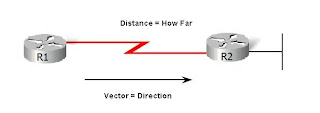Distance Vector is one way to classify a routing protocol based on the algorithm type used to build and sustain their routing tables (Graziani & Johnson, 2009) . Largely, Distance Vector routing protocols have been used for many years by network administrators to overcome the problems that arose when using static routing configuration.
It selects the best path based on how far the destination is, regardless of link load, reliability or delay. Normally, Distance is calculated by the number of hops or by a combination of parameters that represent distance. Distance Vector routing protocol include Routing Information protocol (RIP), Interior Gateway Routing Protocol (IGRP) and Enhanced Interior Gateway Routing Protocol (EIGRP)
It selects the best path based on how far the destination is, regardless of link load, reliability or delay. Normally, Distance is calculated by the number of hops or by a combination of parameters that represent distance. Distance Vector routing protocol include Routing Information protocol (RIP), Interior Gateway Routing Protocol (IGRP) and Enhanced Interior Gateway Routing Protocol (EIGRP)


0 comments:
Post a Comment